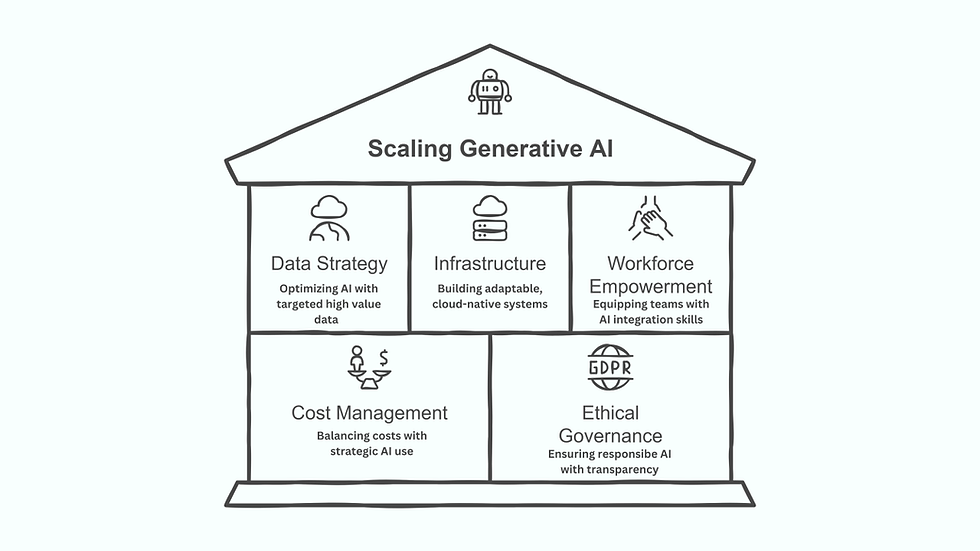Best practices for evaluating your innovation initiatives
- Atika Kumar
- May 31, 2023
- 4 min read
According to Deloitte’s State of AI in the Enterprise report, 42% of the respondents said that one of the key challenges in Scaling #ArtificialIntelligence initiatives is Identifying use case with great business value. That’s quite a significant percentage given that #AI technology is fairly at a mature stage!
With that said, whether its AI initiatives or #DigitalTransformation at large, when we think about business cases, we often focus on the business value of the opportunity. But opportunities can encompass more than just business value.
Firstly, value for a change can be ascribed to additional aspects, and secondly, the constraints/challenges associated with the change are also important. Let’s first talk about the 4 different value types that may be looked into when evaluating a business case:
1. Customer Value is focused on how your customers will benefit from the solution. This is a good way to evaluate an opportunity if you are working in a B2B context or if your product or service is sold through partners and distributors.
2. Employee Value is what employees will gain from using a new feature or service, such as hands-on knowledge, increased productivity, or improved efficiency. For example, to upskill employees on a technology, it might be worth to build a solution in-house with partners or build upon a software solution. The knowledge gained during the experience can then be leveraged for evaluating and scaling other digital initiatives across the organization. In this specific example, one of the big advantages of this approach is that it allows one to blend existing and new ways of working to industrialize solutions in much more methodical and humane way.
3. Social Value is about how society at large will benefit from new technology or innovation (for example, environmental responsibility). It's important to consider social impact when thinking about whether or not an idea makes sense for your organization because it can improve your reputation and brand image among stakeholders such as investors, customers, suppliers and other community members. An example approach would be to have communities and/or free information exchange to facilitate improved healthcare to patients. When looking at technical enhancements that often get de-prioritized, probably looking at reduced carbon footprint for the business can be an evaluating factor.
4. Lastly but one of top factors, Business Value - This is where the intent of the change has to be thought about and what impact the initiative would have on organization’s strategy and goals. The intent could be any of the 3 categories – Re-imaging the end to end experience; Innovating from ground up; or Optimizing the current operations for more efficiency. Most of the changes today, fall in the 3rd category especially in recent times of tightened economic conditions.
Having understood the first pillar – value, let’s delve into the second one - constraints or challenges. This pillar would facilitate creating a #holistic roadmap to overcome uncertainties and developing a robust solution. The key constraint categories are :
Business Strategy - The first thing to consider is whether the digital transformation initiative aligns with the overall business strategy. Do they fit together? Is this initiative helping you achieve your goals? Will it improve customer experience?
Regulatory Requirements - Understanding these requirements (e.g., GDPR, Data privacy regulation, Local Laws such as EU AI Act etc) are essential as they may not only affect your ability to deliver or scale your solution but can also have an impact on your reputation and revenue. As per EU AI Act, an organization can be fined upto 6% of its global turnover for a serious violation. If there are any regulatory constraints, communication to stakeholders would be important to avoid any misplaced expectations and would highlight any new potential collaboration needed for the roll-out of the solution.
Risk Tolerance - Gaining an understanding of risk would be the first step to knowing the mitigation steps. We don’t want to implement something too risky for your organization if it doesn’t provide enough value for the cost associated with implementing it.
Culture and Org Structures - Whether a digital solution was successful or not is determined on how it operates post deployment. And often the reason to failing initiatives is lack of adaptability of the organization due to legacy culture or the organizational structure. Understanding where the organization is at in the overall transformation journey, what is the current state of the process- pain points, stakeholders involves and most importantly the “wins” would help evaluate the degree of the change required and in turn the risk. An example of my understanding the current state and transforming it into something better is when I helped a UK-based Fortune 500 company retain its reputation for having the best onboarding experience. In that situation, I knew what worked and what didn't because it was important to retain our legacy of winning awards.
Budget Constraints - Digital transformation is not a cheap investment. For organizations that have a less-than-stellar transformation strategy, scope creep can slowly start to push back deadlines and add in new work – all adding to the cost of a project. Add in any consultation work, changes in your customer needs or IT errors, and the cost of digital transformation continues to increase.
While there are certainly other factors to consider, these are a great start to create a strong business case for your transformation initiative. Always be sure to tailor your approach to the specifics of your organization and the industry in which you work. Chances are, there will be additional elements that apply specifically to your situation, so always plan ahead and strategize with an eye to finding success for any initiative.
I would love to hear your experiences with your organization's Digital Transformation and AI journey, please share your thoughts in the comments.



Comments